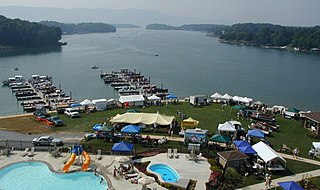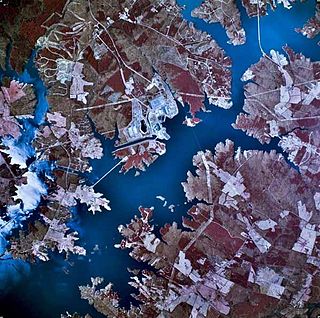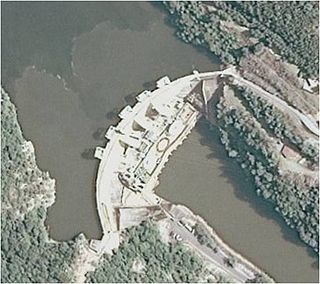
The Roanoke River runs 410 miles (660 km) long through southern Virginia and northeastern North Carolina in the United States. A major river of the southeastern United States, it drains a largely rural area of the coastal plain from the eastern edge of the Appalachian Mountains southeast across the Piedmont to Albemarle Sound. An important river throughout the history of the United States, it was the site of early settlement in the Virginia Colony and the Carolina Colony. An 81-mile (130 km) section of its lower course in Virginia between the Leesville Lake and Kerr Lake is known as the Staunton River, pronounced, as is the Shenandoah Valley city of that name. It is impounded along much of its middle course to form a chain of reservoirs.
Konawa Reservoir is a reservoir located in Seminole County, Oklahoma. The lake covers approximately 1,350 acres (5.5 km2) and has a capacity of 23,000 acre-feet (28,000,000 m3). It is owned by Oklahoma Gas and Electric (OG&E) Company. and was constructed in 1968-70, to provide cooling for a nearby gas-fired electric power generation plant. It impounds Jumper Creek, about 2 miles (3.2 km) east of the city of Konawa, Oklahoma.

Claytor Lake in Pulaski County, Virginia, is a 4,472-acre (1,810 ha), 21-mile-long (34 km) reservoir on the New River, created for an Appalachian Power Company hydroelectric project. It is named for W. Graham Claytor, Sr. (1886–1971) of Roanoke, Virginia, a vice president of Appalachian Power who had supervised the construction of the Claytor Dam, which created the lake.

Lake Cumberland is a reservoir in Clinton, Pulaski, Russell, Wayne, and Laurel, counties in Kentucky. The primary reasons for its construction were a means for flood control and the production of hydroelectric power. Its shoreline measures 1,255 miles (2,020 km) and the lake covers 65,530 acres (265 km2) at the maximum power pool elevation. The reservoir ranks 9th in the U.S. in size, with a capacity of 6,100,000 acre-feet (7.5 km3) of water, enough to cover the entire Commonwealth of Kentucky with 3 inches (76 mm) of water. The main lake is 101 miles (163 km) long and over one mile (1.6 km) across at its widest point.

Lake Havasu is a large reservoir formed by Parker Dam on the Colorado River, on the border between San Bernardino County, California and Mohave County, Arizona. Lake Havasu City sits on the Arizonan side of the lake with its Californian counterpart of Havasu Lake directly across the lake. The reservoir has an available capacity of 619,400 acre-feet (764,000,000 m3). The concrete arch dam was built by the United States Bureau of Reclamation between 1934 and 1938. The lake's primary purpose is to store water for pumping into two aqueducts. Prior to the dam construction, the area was home to the Mojave people. The lake was named after the Mojave word for blue. In the early 19th century, it was frequented by beaver trappers. Spaniards also began to mine the areas along the river.

Table Rock Lake is an artificial lake or reservoir in the Ozarks of southwestern Missouri and northwestern Arkansas in the United States. Designed, built and operated by the U.S. Army Corps of Engineers, the lake is impounded by Table Rock Dam, which was constructed from 1954 to 1958 on the White River.

Smith Mountain Lake is a large reservoir in the Roanoke Region of Virginia, United States, located southeast of the City of Roanoke and southwest of Lynchburg. The lake was created in 1963 by the Smith Mountain Dam impounding the Roanoke River. The majority of the south shore of the lake lies in Franklin County while a small portion, including access to the dam, lies in Pittsylvania County. Bedford County makes up the northern half of the lake with the Roanoke River as the dividing line. The lake has become a popular recreation spot and has also experienced significant development in the last decade. It is the largest lake contained entirely within the Commonwealth of Virginia.

Lake Anna is one of the largest freshwater inland reservoirs in Virginia, covering an area of 13,000 acres (53 km2), and located 72 miles (116 km) south of Washington, D.C., in Louisa and Spotsylvania counties. The lake is easily accessible from Fredericksburg, Richmond, Charlottesville, Northern Virginia, and Washington, D.C., and is one of the most popular recreational lakes in the state.

Dworshak Dam is a concrete gravity dam in the western United States, on the North Fork of the Clearwater River in north central Idaho. In Clearwater County, the dam is located approximately four miles (6 km) northwest of Orofino and impounds the Dworshak Reservoir for flood control and hydroelectricity generation.

The San Luis Reservoir is an artificial lake on San Luis Creek in the eastern slopes of the Diablo Range of Merced County, California, approximately 12 mi (19 km) west of Los Banos on State Route 152, which crosses Pacheco Pass and runs along its north shore. It is the fifth largest reservoir in California. The reservoir stores water taken from the San Joaquin-Sacramento River Delta. Water is pumped uphill into the reservoir from the O'Neill Forebay which is fed by the California Aqueduct and is released back into the forebay to continue downstream along the aqueduct as needed for farm irrigation and other uses. Depending on water levels, the reservoir is approximately nine miles (14 km) long from north to south at its longest point, and five miles (8 km) wide. At the eastern end of the reservoir is the San Luis Dam, the fourth largest embankment dam in the United States, which allows for a total capacity of 2,041,000 acre-feet (2,518,000 dam3). Pacheco State Park lies along its western shores.

Raccoon Mountain Pumped-Storage Plant is a pumped-storage hydroelectric underground power station in Marion County, just west of Chattanooga in the U.S. state of Tennessee.

Summersville Lake is a reservoir located in the US state of West Virginia. The lake is formed by a rock-fill dam on the Gauley River, south of Summersville in Nicholas County. It is the largest lake in West Virginia, with 2,700 acres (1,100 ha) of water and over 60 miles (97 km) of shoreline at the summer pool water level. Its maximum depth is 327 feet.

Lake Gaston is a hydroelectric reservoir in the eastern United States. Part of the lake is in the North Carolina counties of Halifax, Northampton, and Warren. The part extending into Virginia lies in Brunswick and Mecklenburg counties. Lake Gaston is roughly 35 miles (56 km) long and covers over 20,000 acres (81 km2), with 350 miles (560 km) of shoreline.

Douglas Dam is a hydroelectric dam on the French Broad River in Sevier County, Tennessee, in the southeastern United States. The dam is operated by the Tennessee Valley Authority (TVA), which built the dam in record time in the early 1940s to meet emergency energy demands at the height of World War II. Douglas Dam is a straight reinforced concrete gravity-type dam 1705 feet long and 202 feet high, impounding the 28,420-acre (11,500 ha) Douglas Lake. The dam was named for Douglas Bluff, a cliff overlooking the dam site prior to construction.

The Oroville–Thermalito Complex is a group of reservoirs, structures, and facilities located in and around the city of Oroville in Butte County, California. The complex serves not only as a regional water conveyance and storage system, but is the headwaters for, and therefore perhaps is the most vital part of, the California Department of Water Resources' State Water Project, as one of the largest publicly built and operated water and power development and conveyance systems.

Hiwassee Dam is a hydroelectric dam on the Hiwassee River in Cherokee County, in the U.S. state of North Carolina. It is one of three dams on the river owned and operated by the Tennessee Valley Authority, which built the dam in the late 1930s to bring flood control and electricity to the region. The dam impounds the Hiwassee Lake of 6,000 acres (2,400 ha), and its tailwaters are part of Apalachia Lake. At 307 feet (94 m), Hiwassee Dam is the highest overspill dam in the Eastern United States and third only to Shasta and Grand Coulee dams in the nation. At the time it was completed, it was the highest overspill dam in the world.

Smith Mountain Dam is a concrete arch dam located on the Roanoke River in Virginia, creating Smith Mountain Lake. The dam was built by Appalachian Power between 1960 and 1963 for the purposes of pumped-storage hydroelectricity. The dam created Smith Mountain Lake as its reservoir, where recreation and real estate have become popular.

Castaic Power Plant, also known as the Castaic Pumped-Storage Plant, is a seven unit pumped-storage hydroelectric plant, operated by the Los Angeles Department of Water and Power, which provides peak load power from the falling water on the West Branch of the California State Aqueduct. It is a cooperative venture between the LADWP and the Department of Water Resources of the State of California. An agreement between the two organizations was signed on September 2, 1966, for construction of the project.
The Salina Pumped Storage Project is a 260-megawatt (350,000 hp) pumped-storage power station near Salina, Oklahoma. It is owned and operated by the Grand River Dam Authority (GRDA). Its construction was in response to growing power demands and a lack of dam sites on the Grand River. The first phase was completed in 1968 and the second in 1971. The upper reservoir for the power station is Lake W. R. Holway which was built on Saline Creek and the lower reservoir is Lake Hudson on the Grand River. During periods of lower power demand, water is pumped from Lake Hudson to Lake Holway and released back down through the pump-generators during periods of high energy demand.

Norris Lake, also known as Norris Reservoir, is a reservoir that is located in Tennessee. The lake was created by the Norris Dam at the Cove Creek Site on the Clinch River in 1936 by the Tennessee Valley Authority (TVA) for flood control, water storage, and hydroelectric power. Norris Dam and its reservoir were the first major project taken on by the TVA. The lake, the dam, and the town of Norris, Tennessee are named for George W. Norris, who was a U.S. Senator from Nebraska and who wrote the legislation that created the TVA.




















